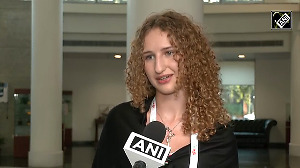Mutual funds have discovered that they are able to mobilise funds cheaply through IPOs. Given the big stock market rally in the last two years and the increasing polarisation of assets under management -- the whales of the industry have most of the assets under management, while the minnows have much less -- many fund managers anticipated heightened M&A activity.
Several recent IPOs garnered large sums. Templeton Mutual Fund mobilised more than Rs 1,950 crore (Rs 19.5 billion) in its IPO, making it the largest equity fund IPO in the last 10 years. Reliance Mutual Fund mobilised more than Rs 1,750 crore (Rs 17.5 billion) in its IPO, while Fidelity Mutual Fund is said to have mobilised over Rs 1,500 crore (Rs 15 billion) in its maiden issue.
Kotak Mutual Fund's Mid-Cap Fund IPO raised more than Rs 570 crore (Rs 5.7 billion) in January 2005 and Tata Mutual Fund garnered more than Rs 700 crore (Rs 7 billion) in its IPO for Tata Infrastructure Fund in December 2004.
"There is always a lot of pressure from promoters of asset management companies to not only perform well but also have bigger assets under management. Earlier, people looked at M&As as an impetus to the organic growth of assets under management and their investor base. But they have started realising it is cheaper and easier to do this organically through IPOs. This also helps build brand value because of the extended marketing involved," explains a senior fund manager at a domestic mutual fund.
"Earlier, M&A deals in the fund industry saw acquisition prices soar to as high as 8-9 per cent of the assets under management. However, raising money through IPOs costs about 4-6 per cent and even this is ultimately passed on to the investor in most cases," notes Rajiv Shastri, chief executive officer at Sahara Mutual Fund.
N R Ramanujam, managing director at Canbank Mutual Fund, which recently acquired GIC mutual fund's assets and also had two successful IPOs, broadly backs the point.
"Organic growth is the mainstay and will continue to remain so. But we will consider M&As on merit. Inorganic growth has its advantages as one can not only add assets under management but also get a ready investor base," he says.
To be sure, no one is ruling out keeping off the M&A trail either.
Industry sources said given the performance of many AMCs, the funds might still be rocked by big-ticket M&As as many of them were looking to exit the business at the right price as promoter pressure increased. They added that the price might come down.
The reasoning applies in particular to joint venture funds, where the foreign partner has a predominant interest. At least a couple of such funds are said to have been hauled up by their foreign partners in
These funds have not fared too well in terms of financial performance, as well as in mobilising their assets under management.
In fact, their assets under management has declined consistently over time. In some cases, these funds have not been able to add any significant asset. Industry watchers say the size of the assets under management is critical in terms of profitability as the costs of managing a fund are high.
Indeed, many small domestic mutual funds are finding it difficult to expand their investor base or mobilise their assets under management, though the bigger ones are busy raising huge sums of money through IPOs.
The small funds are facing a big problem. Their thin margins and low investor base is making it difficult for them to survive, a mutual fund distributor adds.
"The size of the pie has not grown significantly, while the number of players vying for a share is rather high. In this scenario, the big players are finding it easier to leverage their size, or in some cases their promoter's reach, like bank-sponsored mutual funds," explains Rajendra Naik, managing director at CentrumDirect, a financial products distributor.
Says a fund manager at a fund house looking to acquire a low-priced mutual fund, "We believe such mergers are in the long-term interests of investors as they result in better economies of scale, and given that the total expense ratio limits are linked to the asset size, mergers help in reducing the expense ratio."
The mutual fund industry added Rs 9,637.92 crore (Rs 96.38 billion) of assets under management in the last financial year. Assets under management rose by 6.88 per cent from Rs 140,172 crore (Rs 1402.72 billion) at the end of March 2004 to Rs 149,816 crore (Rs 1498.16 billion) in March 2005.
Despite this, the growth rates of the assets under management of 13 of the 30-odd MFs have dropped. Besides, almost half the industry has assets under management of less than Rs 2,000 crore (Rs 20 billion); eight have assets of under Rs 1,000 crore (Rs 10 billion).
The big five in terms of assets under management -- UTI MF, Franklin Templeton MF, Pru ICICI MF, HDFC MF and Birla Sun Life MF -- account for more than half the total assets, indicating the polarisation.
Over the past couple of years, the mutual fund industry has seen a significant number of M&As. The list of notable ones is lengthy. Principal Mutual Fund acquired Sun F&C Mutual Fund's schemes.
Sun F&C Mutual itself acquired the schemes of Jardine Fleming Mutual Fund in June 2002. Templeton Mutual Fund bought out Pioneer ITI Mutual Fund in 2002. HDFC Mutual Fund acquired Zurich India during the same year.
Sundaram Finance took over Newton Investment Management's 39 per cent stake in the joint venture Sundaram-Newton, and, more recently, Birla Sun Life Mutual Fund struck a deal with Alliance Mutual Fund to takeover its assets under management. IL&FS Mutual Fund merged with UTI Mutual Fund and Canbank acquired GIC Mutual Fund's assets.







 © 2025
© 2025